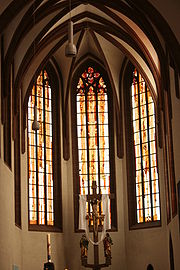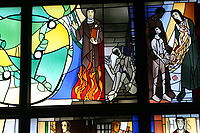
Alois Plum
Encyclopedia

Mainz
Mainz under the Holy Roman Empire, and previously was a Roman fort city which commanded the west bank of the Rhine and formed part of the northernmost frontier of the Roman Empire...
, Germany
Germany
Germany , officially the Federal Republic of Germany , is a federal parliamentary republic in Europe. The country consists of 16 states while the capital and largest city is Berlin. Germany covers an area of 357,021 km2 and has a largely temperate seasonal climate...
, who has acquired a national reputation for his stained glass
Stained glass
The term stained glass can refer to coloured glass as a material or to works produced from it. Throughout its thousand-year history, the term has been applied almost exclusively to the windows of churches and other significant buildings...
, his paintings (esp. mural
Mural
A mural is any piece of artwork painted or applied directly on a wall, ceiling or other large permanent surface. A particularly distinguishing characteristic of mural painting is that the architectural elements of the given space are harmoniously incorporated into the picture.-History:Murals of...
s), and his plastic art. Active since the 1950s, his work decorates hundreds of churches and public buildings in Germany. He has created many characteristic stained glass windows in churches renovated or rebuilt after the destruction of World War II
World War II
World War II, or the Second World War , was a global conflict lasting from 1939 to 1945, involving most of the world's nations—including all of the great powers—eventually forming two opposing military alliances: the Allies and the Axis...
, and is especially noted for his reinterpretation of historic sacred space and his integration of glass and architecture with careful attention to the liturgical function of his art.
Biography, career
Alois Plum was born in 1935, the son of Josef Plum (d. 1988), who is mainly known for designing ecclesiastical paramentParament
A Parament or Parement; , a term applied by ancient writers to the hangings or ornaments of a room of state. Later it has referred to the liturgical hangings on and around the altar, as well as the cloths hanging from the pulpit and lectern, as well as the ecclesiastical vestments and mitres...
s and especially robes and mitre
Mitre
The mitre , also spelled miter, is a type of headwear now known as the traditional, ceremonial head-dress of bishops and certain abbots in the Roman Catholic Church, as well as in the Anglican Communion, some Lutheran churches, and also bishops and certain other clergy in the Eastern Orthodox...
s. Josef Plum was also a painter and graphic artist, noted for his religious imagery. Alois Plum was trained at the Landeskunstschule in Mainz from 1951 to 1955, and spent a summer studying in Salzburg with Oskar Kokoschka
Oskar Kokoschka
Oskar Kokoschka was an Austrian artist, poet and playwright best known for his intense expressionistic portraits and landscapes.-Biography:...
. From 1955 to 1957 he studied with Georg Meistermann at the Kunstakademie Düsseldorf
Kunstakademie Düsseldorf
The Kunstakademie Düsseldorf, formerly Staatliche Kunstakademie Düsseldorf, is the Arts Academy of the city of Düsseldorf. It is well known for having produced many famous artists, such as Joseph Beuys, Gerhard Richter, Sigmar Polke, Thomas Demand, and Andreas Gursky...
, and since 1957 has worked independently in Mainz. His first work as a stained glass artist was executed in 1954, in the parish church in Niederrœdern
Niederrœdern
Niederrœdern is a commune in the Bas-Rhin department in Alsace in north-eastern France.-References:*...
. A notable early work was a mosaic
Mosaic
Mosaic is the art of creating images with an assemblage of small pieces of colored glass, stone, or other materials. It may be a technique of decorative art, an aspect of interior decoration, or of cultural and spiritual significance as in a cathedral...
of the Stations of the Cross
Stations of the Cross
Stations of the Cross refers to the depiction of the final hours of Jesus, and the devotion commemorating the Passion. The tradition as chapel devotion began with St...
in Steinheim. Perhaps his largest work to date can be found in the Worms Cathedral
Worms Cathedral
Cathedral of St Peter is a church in Worms, southern Germany. It was the seat of the Catholic Prince-Bishopric of Worms until its extinction in 1800.It is a basilica with four round towers, two large domes, and a choir at each end...
, for which he designed, over three decades, a large number of stained glass windows; the earlier windows (dating to 1911) had been destroyed by allied bombing in 1943.
Plum's assignments come from all over Germany. Sometimes the themes are dictated, sometimes he is free to choose, in which case Plum decided between figurative or symbolical representations. He is usually free in his choice of material, and his oeuvre includes works in many different materials, including traditional stained glass (set in lead), glass set in concrete
Concrete
Concrete is a composite construction material, composed of cement and other cementitious materials such as fly ash and slag cement, aggregate , water and chemical admixtures.The word concrete comes from the Latin word...
(Plum uses two different kinds: "Dallglas," an opaque float glass
Float glass
Float glass is a sheet of glass made by floating molten glass on a bed of molten metal, typically tin, although lead and various low melting point alloys were used in the past. This method gives the sheet uniform thickness and very flat surfaces. Modern windows are made from float glass...
, and "Antikglass," a handblown
Glassblowing
Glassblowing is a glassforming technique that involves inflating molten glass into a bubble, or parison, with the aid of a blowpipe, or blow tube...
glass), and glass brick
Glass brick
Glass brick, also known as glass block, is an architectural element made from glass. Glass bricks provide visual obscuration while admitting light...
.
In 2010, Cardinal Karl Lehmann, Bishop of Mainz, praised Plum for his art and the service it performs to the greater good, in a book that explains the Catholic creed
Creed
A creed is a statement of belief—usually a statement of faith that describes the beliefs shared by a religious community—and is often recited as part of a religious service. When the statement of faith is longer and polemical, as well as didactic, it is not called a creed but a Confession of faith...
and uses Plum's stained glass for illustrating elements of the creed.
Notable works

- Blessed Virgin Mary, reliefReliefRelief is a sculptural technique. The term relief is from the Latin verb levo, to raise. To create a sculpture in relief is thus to give the impression that the sculpted material has been raised above the background plane...
, Mainz-Weisenau, 1954 (rest. 2004). - Stained glass windows, St. Bartholomew church, SaulheimSaulheimSaulheim is an Ortsgemeinde – a municipality belonging to a Verbandsgemeinde, a kind of collective municipality – in the Alzey-Worms district in Rhineland-Palatinate, Germany.- Location :...
, 1957. - Mural behind altar, Lutherkirche, KölnKOLNKOLN, digital channel 10, is the CBS affiliate in Lincoln, Nebraska. It operates a satellite station, KGIN, on digital channel 11 in Grand Island. KGIN repeats all KOLN programming, but airs separate commercials...
, 1963, for newly-built protestant church designed by Otto Vogel. - Stained glass windows and glass wall in St. Christopher church, Mainz (destroyed in WW2, partly rebuilt as a monument), 1964
- Stained glass windows, Worms CathedralWorms CathedralCathedral of St Peter is a church in Worms, southern Germany. It was the seat of the Catholic Prince-Bishopric of Worms until its extinction in 1800.It is a basilica with four round towers, two large domes, and a choir at each end...
, WormsWorms, GermanyWorms is a city in Rhineland-Palatinate, Germany, on the Rhine River. At the end of 2004, it had 85,829 inhabitants.Established by the Celts, who called it Borbetomagus, Worms today remains embattled with the cities Trier and Cologne over the title of "Oldest City in Germany." Worms is the only...
, 1966-1995. Includes nineteen windows in the clerestoryClerestoryClerestory is an architectural term that historically denoted an upper level of a Roman basilica or of the nave of a Romanesque or Gothic church, the walls of which rise above the rooflines of the lower aisles and are pierced with windows. In modern usage, clerestory refers to any high windows...
, ten in the ambulatoryAmbulatoryThe ambulatory is the covered passage around a cloister. The term is sometimes applied to the procession way around the east end of a cathedral or large church and behind the high altar....
, and thirteen in the naveNaveIn Romanesque and Gothic Christian abbey, cathedral basilica and church architecture, the nave is the central approach to the high altar, the main body of the church. "Nave" was probably suggested by the keel shape of its vaulting...
, among others, adding a "highly personal interpretation" to the church." Esp. notable is the "Valentine window" (1978), dedicated to Saint ValentineSaint ValentineSaint Valentine is the name of several martyred saints of ancient Rome. The name "Valentine", derived from valens , was popular in Late Antiquity...
of Terni. - Mural, Sankt Kilian church in Mainz-KostheimMainz-KostheimMainz-Kostheim is a district administered by the city of Wiesbaden, Germany. Mainz-Kostheim was formerly a district of the city of Mainz, until the public administration by the city of Wiesbaden was decided on August 10, 1945...
, 1984. - Stained glass windows, Mariae HimmelfahrtAssumption of MaryAccording to the belief of Christians of the Roman Catholic Church, Eastern Orthodoxy, Oriental Orthodoxy, and parts of the Anglican Communion and Continuing Anglicanism, the Assumption of Mary was the bodily taking up of the Virgin Mary into Heaven at the end of her life...
church, Mainz-Weisenau, 1965-2005. - Stained glass windows, Herz-Jesu church, in Mainz-Mombach, 1970.

